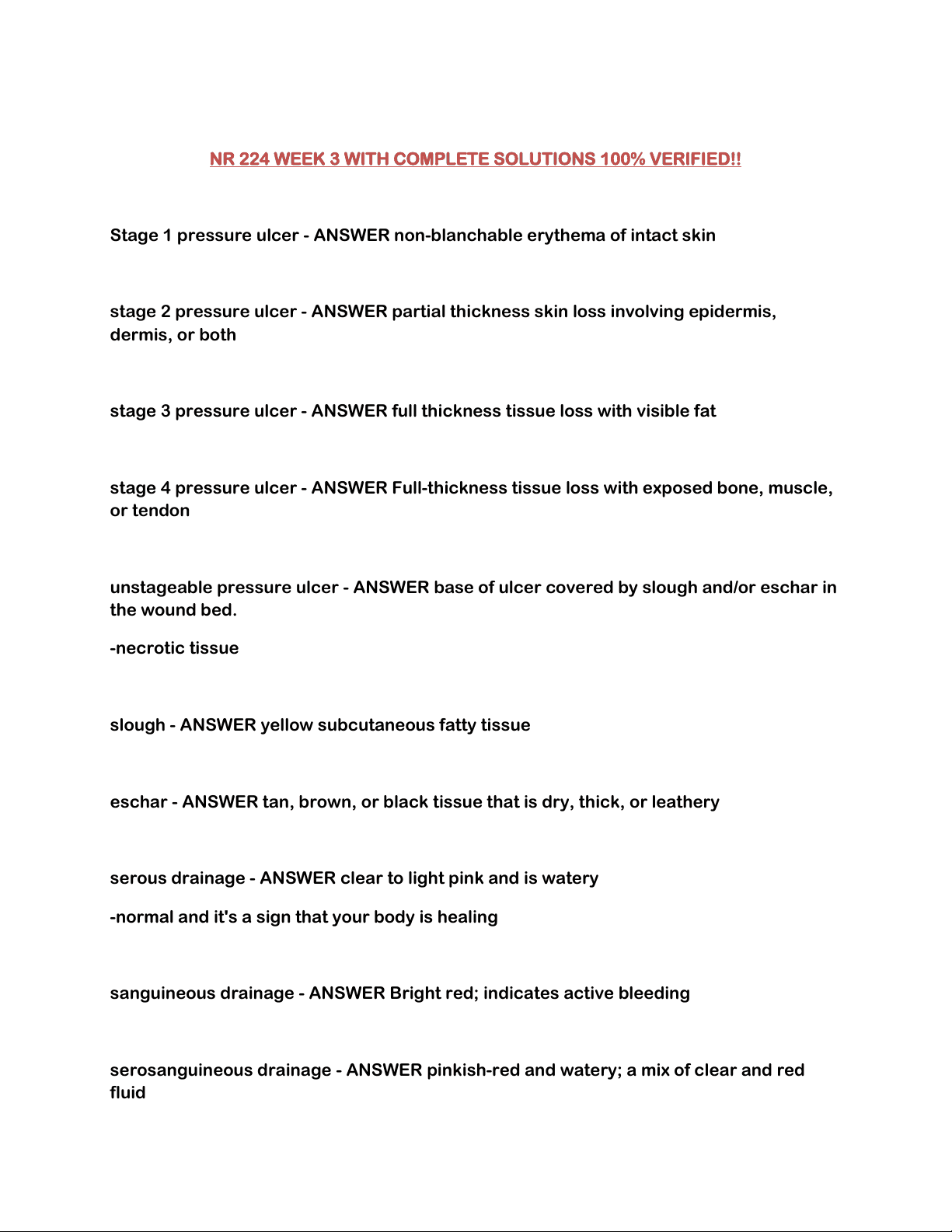
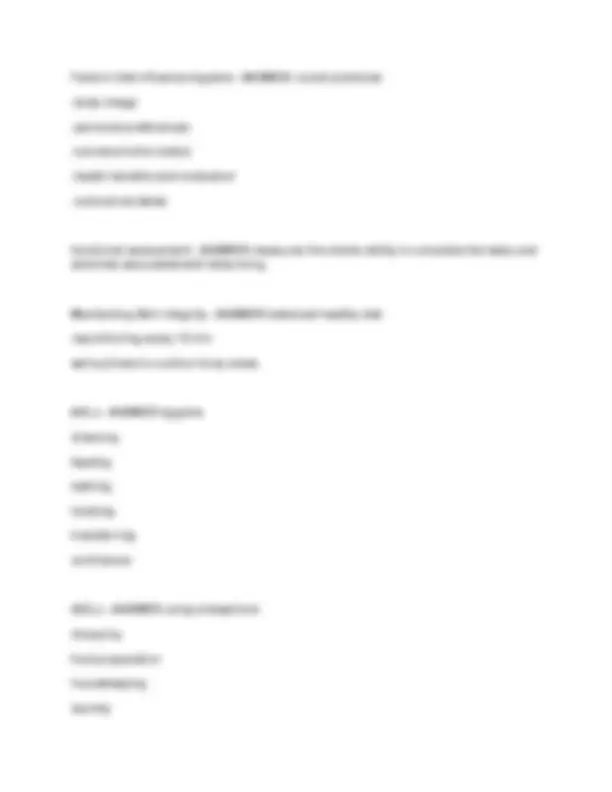
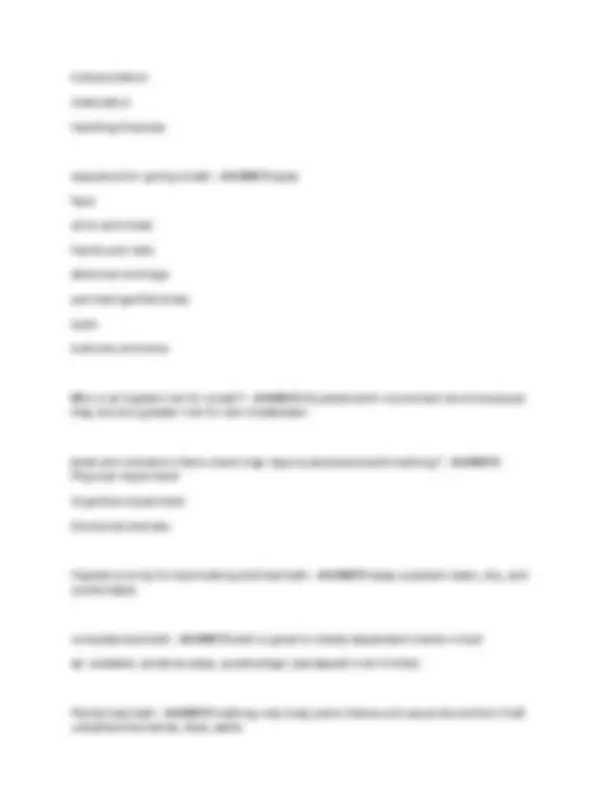
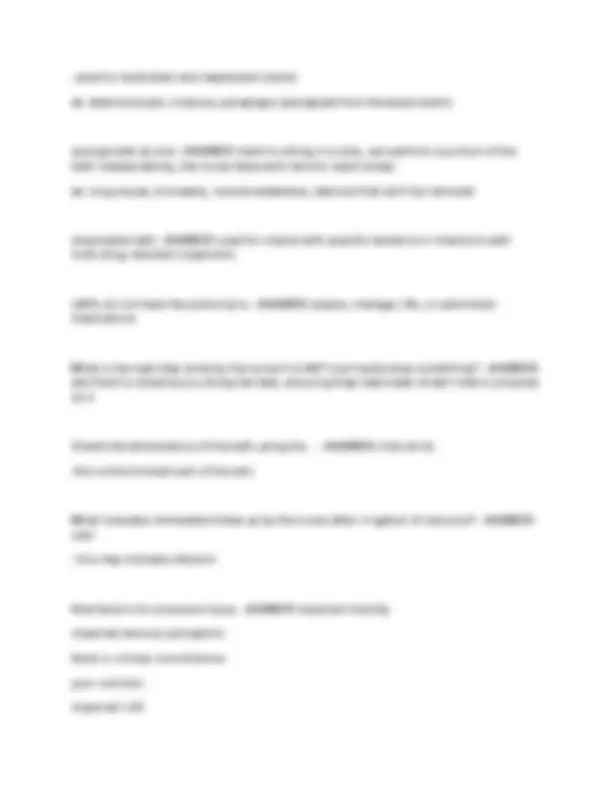
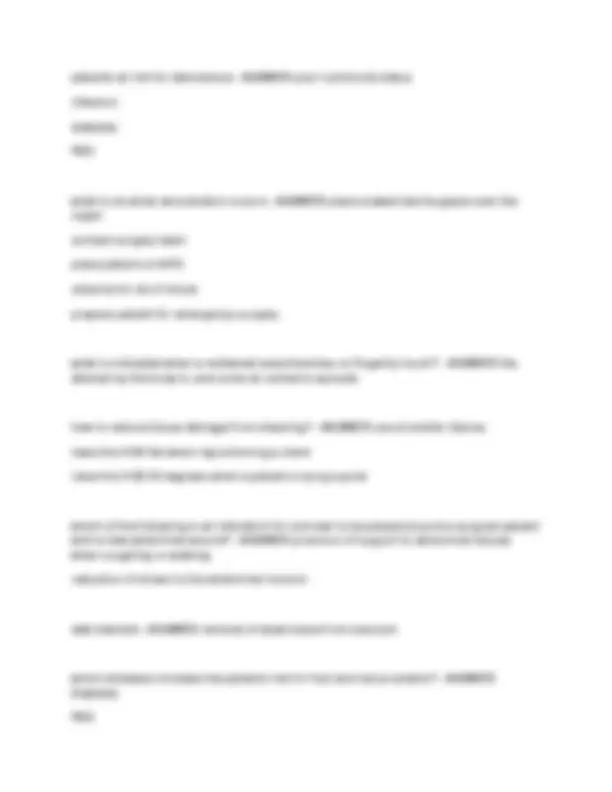


Study with the several resources on Docsity

Earn points by helping other students or get them with a premium plan


Prepare for your exams
Study with the several resources on Docsity

Earn points to download
Earn points by helping other students or get them with a premium plan
Community
Ask the community for help and clear up your study doubts
Discover the best universities in your country according to Docsity users
Free resources
Download our free guides on studying techniques, anxiety management strategies, and thesis advice from Docsity tutors
NR 224 WEEK 3 WITH COMPLETE SOLUTIONS 100% VERIFIED!!
Typology: Exams
1 / 8

This page cannot be seen from the preview
Don't miss anything!





Stage 1 pressure ulcer - ANSWER non-blanchable erythema of intact skin
stage 2 pressure ulcer - ANSWER partial thickness skin loss involving epidermis, dermis, or both
stage 3 pressure ulcer - ANSWER full thickness tissue loss with visible fat
stage 4 pressure ulcer - ANSWER Full-thickness tissue loss with exposed bone, muscle, or tendon
unstageable pressure ulcer - ANSWER base of ulcer covered by slough and/or eschar in the wound bed. -necrotic tissue
slough - ANSWER yellow subcutaneous fatty tissue
eschar - ANSWER tan, brown, or black tissue that is dry, thick, or leathery
serous drainage - ANSWER clear to light pink and is watery -normal and it's a sign that your body is healing
sanguineous drainage - ANSWER Bright red; indicates active bleeding
serosanguineous drainage - ANSWER pinkish-red and watery; a mix of clear and red fluid
Primary intention healing - ANSWER edges remain close (well approximated) heals quickly, without minimal loss of tissue ex: surgical wound closed by sutures
secondary intention healing - ANSWER wound in which the tissue surfaces are not approximated and there is extensive tissue loss -the wound will be left open and heal from the edges inward ex: pressure injury, burn
Dehiscence - ANSWER partial or total separation of wound layers
Evisceration - ANSWER dehiscence that involves the protrusion of visceral organs through a wound opening
purulent drainage - ANSWER thick green, yellow, or brown drainage -sign of infection
Hydrogel dressing - ANSWER contain a large amount of water that keeps ulcers moist rather than letting them become dry.
hydrocolloid dressing - ANSWER used in the treatment of non-infected, mildly exuding wounds, such as minor burns or pressure ulcers, also known as bed sores.
foam and alginate dressings - ANSWER for wounds with large amounts of exudate and those that need packing
transparent dressing - ANSWER protects redness from opening up -used for stage 1
transportation medication handling finances
sequence for giving a bath - ANSWER eyes face arms and chest hands and nails abdomen and legs perineal (genital area) back buttocks and anus
Who is at highest risk for a bath? - ANSWER A patient with incontinent stools because they are at a greater risk for skin breakdown
what are indicators that a client may require assistance with bathing? - ANSWER Physical impairment Cognitive impairment Emotional distress
Highest priority for bed making and bed bath - ANSWER keep a patient clean, dry, and comfortable
complete bed bath - ANSWER bath is given to totally dependent clients in bed ex: sedated, cerebral palsy, quadriplegic (paralyzed in all 4 limbs)
Partial bed bath - ANSWER bathing only body parts that would cause discomfort if left unbathed like hands, face, axilla
-used for bedridden and dependent clients ex: extensive pain, hospice, paraplegic (paralyzed from the waist down)
sponge bath at sink - ANSWER client is sitting in a chai, can perform a portion of the bath independently, the nurse helps with hard to reach areas ex: lung issues, tire easily, muscle weakness, devices that can't be removed
disposable bath - ANSWER used for clients with specific bacteria or infections with multi-drug resistant organisms
UAPs do not have the authority to - ANSWER assess, manage, IVs, or administer medications
What is the next step done by the nurse if a UAP incorrectly does something? - ANSWER ask them to observe you doing the task, ensuring they have been shown how to properly do it
Check the temperature of the bath using the... - ANSWER inner wrist -this is the thinnest part of the skin
What indicates immediate follow up by the nurse after irrigation of a wound? - ANSWER odor
Risk factors for pressure injury - ANSWER impaired mobility impaired sensory perception fecal or urinary incontinence poor nutrition impaired LOC
actions that promote pressure injury prevention - ANSWER provide a trapeze bar to facilitate movement in bed adaquete nutrition and fluid intake establish an individualized turning schedule placing a pillow under the clients feet
Risk factors for impaired tissue integrity - ANSWER immobility tobacco smoking poor nutritional status
Blanchable - ANSWER red when it blanches, turns white when pressed with a fingertip, and then immediately turns red again when pressure is removed
Non-blanchable - ANSWER skins stay very red even with finger pressure; indicates severe skin injury
Chelitis - ANSWER inflammation of the lips -cracked lips
Edentulous - ANSWER lacking teeth
effleurage - ANSWER a form of massage involving a circular stroking movement made with the palm of the hand.
Maceration - ANSWER the softening and breaking down of skin as a result of prolonged exposure to moisture
Xerostomia - ANSWER dry mouth
patients at risk for dehiscence - ANSWER poor nutritional status infection diabetes PVD
what to do when evisceration occurs - ANSWER place soaked sterile gauze over the organ contact surgery team place patient on NPO observe for s/s of shock prepare patient for emergency surgery
what is indicated when a reddened area blanches on fingertip touch? - ANSWER the attempt by the body to overcome an ischemic episode
how to reduce tissue damage from shearing? - ANSWER use a transfer device have the HOB flat when repositioning a client raise the HOB 30 degrees when a patient is lying supine
which of the following is an indication for a binder to be placed around a surgical patient with a new abdominal wound? - ANSWER provision of support to abdominal tissues when coughing or walking reduction of stress to the abdominal incision
debridement - ANSWER removal of dead tissue from a wound
which diseases increase the patients risk for foot and nail problems? - ANSWER Diabetes PVD